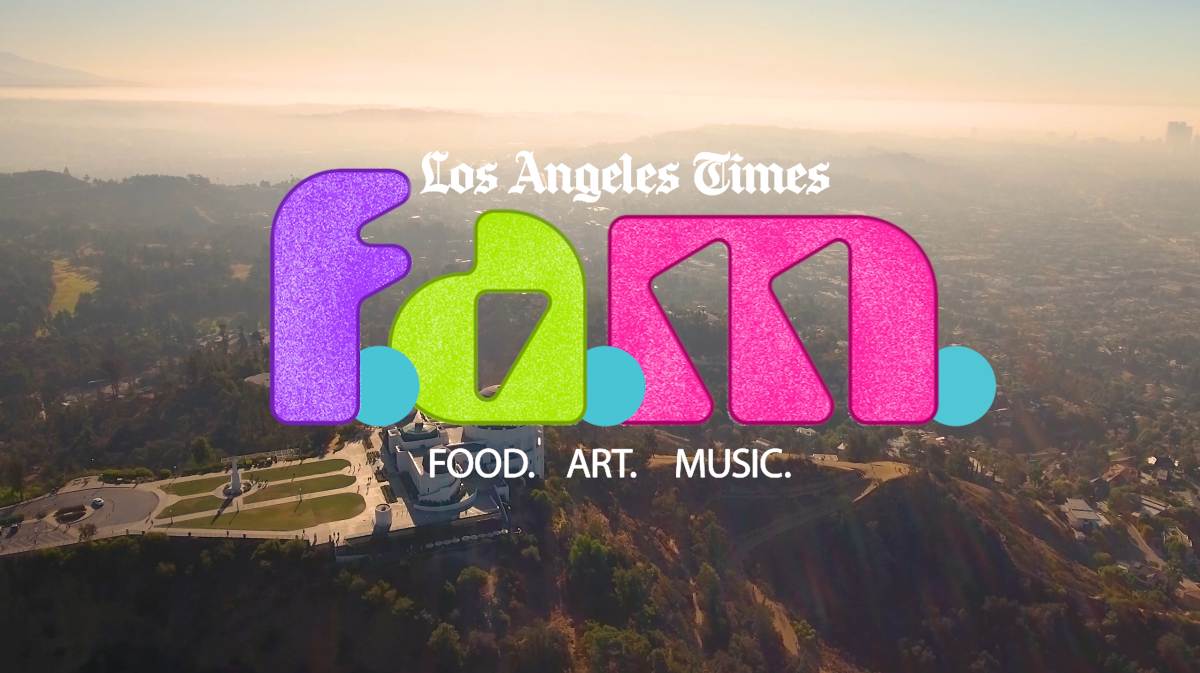Embracing the L.A. F.A.M.

- Share via
Good morning, and welcome to the Essential California newsletter. It’s Thursday, July 13.
Our names are Marcos James and Carlos Lopéz Estrada. We are two of the six creators behind the L.A. Times’ new documentary series L.A. Times F.A.M., which stands for Food, Art and Music. Before we get too deep into what exactly F.A.M. is, we want to share a story with you.
In the summer of 2019, a group of local spoken word poets and an indie film director sat in an un-air-conditioned office in Koreatown. The group felt that Los Angeles needed a new PR team, one that could expel the transplant narrative that this city is fueled by the vanity of dull personalities. The director came up with a film concept and the poets wrote a screenplay. They named it “Summertime.” Some critics called it a poetic musical, Sundance called it their 2020 festival opening film, and we called it an introduction.
The movie came out theatrically in 2021 and we followed it up with a collection of poetry and visual art titled “Summertime: Odes to LA.” After collaborating creatively for almost four years across a variety of media, we decided there were still more layers of our city we wanted to document.
We know that glamour runs deep in Los Angeles. We’ve heard tales of Mulholland Drive and Laurel Canyon and the Westside. But consider the hum of the Red Line. Remember the clatter of early morning Downtown storefronts. Taste the late-night burger by your favorite yet-to-be-gentrified Tom’s or Pepe’s or Jim’s. These are the interactions that bind us together. They remind us that to live in Los Angeles is to live in a city with arms so wide it embraces all 40 miles of us.
This is the genesis of L.A. Times F.A.M. — a docuseries that is an ode to every ZIP Code in Los Angeles. Through the lenses of food, art and music, L.A. Times F.A.M. reminds us that our hometown heroes deserve a celebration beyond the block. F.A.M. opens with Villa’s Tacos, an Eastside family-owned business with three generations of recipes and a line half a mile long. Their tacos are a reminder that beautiful can be flavorful.
After you learn about a neighborhood staple, our first episode of F.A.M. will introduce you to spoken word poets from across the city to share their art. In Highland Park, Paolina Acuña Gonzalez commands a crowd from the back of a pickup truck; a string quartet serenades her words with rhythm and intention. Local musicians like Alaina Castillo follow with an intimate arrangement of their most popular songs.
Since we filmed this episode a little over a year ago, Villa’s Tacos has migrated from its matriarch’s back patio to its very own brick-and-mortar shop on North Figueroa Street. Victor Villa still welcomes you with a warm smile and the line continues to be half a mile long. These are the type of success stories we want our city to be known for.
F.A.M. is a collage of all the best parts of Los Angeles. It’s a gesture towards a home that we know intimately. And yes, it is impossible for all of us to claim the same experience of this city — yet we map our hearts to connect regardless. We find ourselves in an un-air-conditioned office in Koreatown, searching for the best words to say: home is …
L.A. Times F.A.M. is available to watch now at latimes.com/fam. Check back soon for more episodes!
And now, here’s what’s happening across California from Ryan Fonseca:
Note: Some of the sites we link to may limit the number of stories you can access without subscribing.
CALIFORNIA CULTURE
After 33 years, the city of Modesto has ended its ban on cruising. The repeal was celebrated by car enthusiasts, especially given the history and lore of the local scene. Before “Star Wars,” Modesto native George Lucas directed “American Graffiti,” inspired by his youth spent cruising city streets. The Modesto Bee
Pour one out for Anchor Steam beers. The historic San Francisco brewery, founded in 1896, announced it’s shutting down. Company officials said the business had been struggling even before the pandemic but pointed to the wave of economic impacts it brought to the Bay Area. San Francisco Chronicle
Free online games
Get our free daily crossword puzzle, sudoku, word search and arcade games in our new game center at latimes.com/games.
L.A. STORIES
Tenants facing eviction are often alone in court as they face off against a lawyered-up landlord. L.A. County supervisors want to change that, directing county staff to develop a plan to provide at-risk tenants with legal representation. Los Angeles Times
Vernon’s Farmer John slaughterhouse shut down in February after nearly 100 years of operation. Laid-off workers at the facility — many of them older Latino immigrants — are struggling to find new employment. LAist
Support our journalism
HEALTH AND THE ENVIRONMENT
Residents near Calaveras Big Trees State Park and fans of its California sequoias are fuming months after a prescribed burn caused major damage to the giant trees state parks officials were aiming to better protect from wildfires. As my colleague Alex Wigglesworth reports, the incident has “served to undermine local confidence in how state parks officials perform controlled burns — one of the key tools for reducing the severity of wildfires in an era of extreme drought and climate change.” Los Angeles Times

Locals only! You might remember I shared a story last month about a sea otter swiping surfers’ boards in Santa Cruz. Well, the young otter’s antics have continued since then, with wildlife officials saying the mammal has been unusually aggressive and will need to be removed from the wild. Los Angeles Times
POLITICS AND GOVERNMENT
California State University has a new chancellor. Mildred García is the first Latina to run the 23-campus system, which faces widespread sexual misconduct cases and a $1.5-billion budget shortfall that could lead trustees to raise tuition. Los Angeles Times
After a request from Mayor Karen Bass’ office, the Los Angeles Housing Department said it will investigate 21 residential hotels for potentially violating city housing law. That follows reporting by Capital & Main and ProPublica that found that buildings required to serve as low-cost housing have been renting rooms to tourists. Capital & Main
With contentious bans of books and curriculums across the nation, some California lawmakers want to make it harder for school boards in the Golden State to impose their own. A state Assembly bill now before the Senate would require a two-thirds vote to remove books from classrooms and impose fines on school districts that refuse to provide material or curriculum “that contains inclusive and diverse perspectives.” The Mercury News
AND FINALLY
Today’s California landmark is from Stephen Blakesley of La Jolla: California’s native Matilija Poppy.

Stephen writes:
This native poppy plant and blossom was growing in a La Jolla canyon. All our wonderful native wildflowers are landmarks worth preserving in their native habitats.
What are California’s essential landmarks? Fill out this form to send us your photos of a special spot in California — natural or human-made. Tell us why it’s interesting and what makes it a symbol of life in the Golden State. Please be sure to include only photos taken directly by you. Your submission could be featured in a future edition of the newsletter.
Please let us know what we can do to make this newsletter more useful to you. Send comments to essentialcalifornia@latimes.com.
Sign up for Essential California
The most important California stories and recommendations in your inbox every morning.
You may occasionally receive promotional content from the Los Angeles Times.






